One of the things to remember about 2021 is that it is the first year of the third decade of this century. It is in some ways reassuring to know that time is marching on, and these uncertain times will eventually be behind us. One only needs to look at the disruption caused in supply chains, retail networks, and service businesses caused by COVID-19 alone to recognize we are in historic times.
A year spent in isolation, relying on the sophistication of our technology to keep the threads of civilization together, has destroyed some old paradigms while creating new ones. Tele-everything, from tele-working to tele-shopping to tele-tourism, once considered novel and niche application spaces, have been thrust into the limelight as core societal infrastructures.
Even production-heavy image-oriented industries like entertainment had highly-paid talent that wound up Zooming into people’s living rooms from theirs. In the engineering space, solution sets such as collaborative software, once thought the province of techies and international teams, are now important parts of everyone’s business model.
Beyond the now
With all the focus on the current situation, and the various technologies, solutions, and services being mustered to address it, it is easy to lose sight of the bigger picture and the long-term evolutionary issues. These not-so-new collaborative technologies are hot now, but the underlying broad strokes of advanced software simulation and design tools, along with the related advances in IoT and Cloud-based solutions are creating a new “smart” society.
What that means for the test and evaluation industry, and the engineers and technologists working within it, is a shift from thinking of electronic systems test as a task, to thinking of test as an ongoing awareness. Some of the greatest advancements in product development and creation is the ability to capture and apply data at every step, in a continuous process.
This constant development in real time is a significant force multiplier and boon to the business of creating, producing, and selling products. This is becoming especially apparent in the growth of in-field monitoring of product performance, from smart vehicles having their software updated over the air to factory systems that call for maintenance when they predict failure.
System awareness
The life-cycle of a modern product is a complex one. The days of breadboarding trail circuits is rapidly becoming history, with only hobbyists and tinkerers using benchtop development for core system creation. Today most designs start in a software development environment, where the designer can tweak and test ideas on the fly in real time. The resulting design is not only functional, it probably seamlessly integrates advanced subsystems available from a myriad of suppliers.
The trip to the assembly line is another place where advanced test and evaluation solutions have revolutionized the way things get done. Smart facilities and Industry 4.0 processes have made product production an environment of testing, evaluation, and big data as well. In order to achieve six-sigma performance it is necessary to create and monitor an intelligent factory environment.
Once off the assembly line, many products get tested prior to being sent out into the world, and advanced automated test systems enable such oversight on the scale needed. Things like burn-in and power test have always been important, but now things like operating systems, device interfaces, and security must be tested, evaluated, certified, and enabled before the product hits the street.
This paradigm continues into the real world, as user systems not only track device performance for functionality, maintenance, and fault prediction, such systems are also at the core of user fulfillment and activity monitoring. We are rapidly moving to a point where every powered product that performs a task will have intelligent monitoring and management, usually through the Cloud.
Continuous Test and Evaluation
What this means for the test, measurement, and evaluation industry is that the tools, processes, and skills needed to address problems in design and development are ever more in demand. It also means that there is an educational mission out there to bring the benefits of advanced test and evaluation processes to the entire industry, to every application that can benefit from these advanced tools and solutions.
About the Author
Alix Paultre
Editor-at-Large, Electronic Design
An Army veteran, Alix Paultre was a signals intelligence soldier on the East/West German border in the early ‘80s, and eventually wound up helping launch and run a publication on consumer electronics for the US military stationed in Europe. Alix first began in this industry in 1998 at Electronic Products magazine, and since then has worked for a variety of publications in the embedded electronic engineering space. Alix currently lives in Wiesbaden, Germany.
Also check out his YouTube watch-collecting channel, Talking Timepieces.

